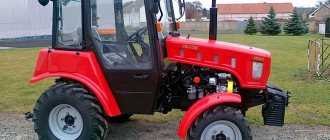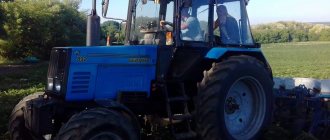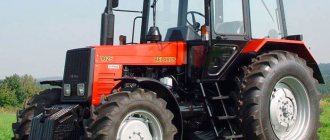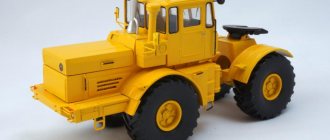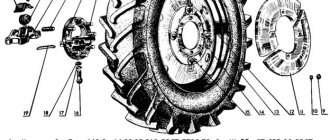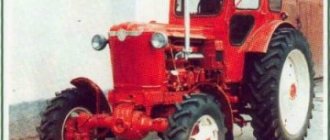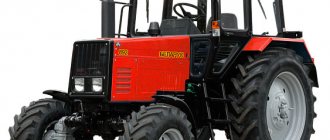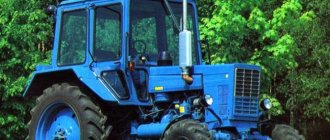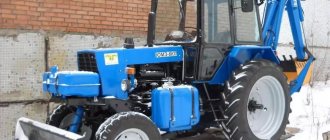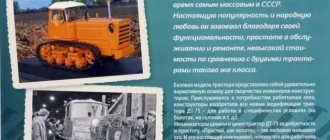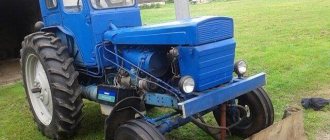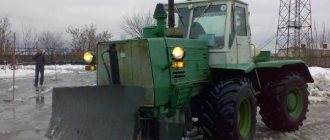Basic tractor Operating power, 60 (81) Transport speed, km/h Overall dimensions Length, mm 7630 Width, mm 2500 Height, mm 3800 Cabin roof height, mm 2725 Operating weight, kg 6350 Excavator equipment Backhoe Bucket capacity, geometric 0.25 nominal 0.28 G digging depth, mm4200 Digging radius at parking level, mm5450 Unloading height, mm3500 Width bucket, mm675 Angle of rotation of excavator equipment in plan, deg. 170 Loading equipment AMKODOR 702 (TO-49) in the basic version is equipped with a quick-change main bucket and a bulldozer fixed blade. Load capacity, kg 750 Bucket capacity, geometric 0.38 nominal 0.44 Cutting edge width, mm 1600 Unloading height, mm2600Bucket edge reach , mm585 Width of bulldozer blade, mm with extensions 2550 without extensions 2100
Photos Amkodor 702 (TO-49) backhoe loader based on the Belarus MTZ 82 tractor
see also
Amkodor 91 (DZ-133ETs) chain excavator-loader based on the MTZ 82 tractor
Amkodor 133 (DZ-133) bulldozer-loader based on the MTZ-80.1 or MTZ-82 tractor
Amkodor 702V (TO-49.40) excavator-bulldozer based on the MTZ 82 tractor
Amkodor PRM-0.4 roll loader - manipulator based on the MTZ-82.1 tractor
Amkodor 91V (DZ-133ETs.40) chain excavator-bulldozer based on the MTZ 82 tractor
EO-3626 ZLATEKS front/jaw loader-excavator with a shifting digging axis based on the MTZ 1221 tractor
EO-2626-CH backhoe loader with a ZLATEKS jaw bucket based on the MTZ 82.1 tractor
Maintenance measures condition of the MTZ 82(80) tractor
Due to the improvement of modifications of MTZ 82(80) tractors, the timing of modern MTZ 80.1, 80.2, 82.1, 82.2 differs from previously produced machines.
The manufacturer regulates the following maintenance activities for the Belarus tractor:
| Types of events | Maintenance frequency in hours | |
| Early modification | Modern modification | |
| When putting a new machine into operation or after a major overhaul. Maintenance in preparation for running in: During the running-in process: After running in: | — — after 30 hours of work | |
| Shift maintenance | 8-10 | 8-10 |
| TO 1 | 60 | 125 |
| TO 2 | 240 | 500 |
| TO 3 | 960 | 1000 |
| Off-season service | During the transition to the autumn-winter and spring-summer periods of operation | |
| Maintenance under special conditions | In preparation for work in special conditions | |
| Storage Installation Maintenance | — | |
ETO - daily maintenance
Conducted before each work shift at the beginning of the working day.
| Operation | Performance |
| Checking the coolant level | At a level of 50 - 60 mm below the upper edge of the filler neck |
| Checking the oil level in the diesel crankcase | To the top mark of the oil dipstick |
| Drain the condensation from the receiver | Until the condensate is completely removed |
| Check the functionality of: diesel engine, steering, lighting brakes, light alarms and windshield wipers | Engine operation must be stable at all speed levels. The controls, all lighting and alarm lamps, and the windshield wiper must be in working order. |
TO-1
Maintenance is carried out with the obligatory preliminary carrying out of shift maintenance operations.
| Operation | performance |
| Tire pressure and tire condition | Tire pressure readings according to tabular data |
| Fan Belt Tension | The deflection of the belt of the “alternator pulley – crankshaft pulley” branch should be 15-22 mm with a pressing force of 40 N |
| Wheel alignment | The distance from the left wheel rim to the right along the front edge should be less than 0 to 8 mm compared to the rear distance |
| No gaps in steering rod joints | Clearance in joints is not allowed |
| Lubricant level in the housings of the FDA bevel gearboxes | To the level of the edge of the filler holes |
| Oil level in the promotional pore housing | To the level of the filler hole edge |
| Lubricating the clutch release bearing with a syringe | 4-6 pumps of lubricant with a syringe |
| Lubrication of pin bearings of planetary helical gearboxes of FDA | 4-6 pumps of lubricant with a syringe |
| Checking the oil level in the air cleaner pan | Up to the level of the ring band in the tray. The presence of mechanical impurities in the filter oil is not allowed. |
| Clean the filter of the ventilation and heating system of a tractor with a unified cab | Clean the filter by shaking and blowing with compressed air |
| Drain the sediment from the fuel coarse filter | Drain the sediment from the filter until clean fuel appears. |
TO-2
Before performing this maintenance operations, perform all TO-1 operations with the exception of checking the oil level in the crankcase.
| Operation | Performance |
| Free play of the clutch pedal | 40-50 mm along the pedal pad |
| Full travel of brake pedals | 70-90 mm (for tractors with a unified cabin 110-120 mm) with a force of 125 N |
| Parking brake lever travel | With a force of 200 N, the lever should lock at 3–4 clicks |
| Radial play of the steering wheel | No more than 25˚ with engine running |
| Pressure drop in the pneumatic system | 6.5-8 kgf/cm² (0.65-0.8 MPa), pressure drop within 30 minutes no more than 2 kgf/cm² (0.2 MPa) |
| Engine cylinder head valve clearance | 0.25+0.05mm on cold diesel for intake and exhaust valves |
| Rear PTO planetary gear control mechanism | The lever activation force should not exceed 120 -150 N. Switching on and off should be clear |
| Pin bearings for planetary spur gearboxes | The force for turning the fist applied to the wheel mounting flange should be within 60-80 N |
| Tightening the intermediate support safety nut | The coupling must transmit torque with a force of 400 - 800 N |
| Checking the oil level: in transmission housings, in the power steering, in the FDA housing and the housings of the FDA wheel gearboxes, in the rear final drives of the MTZ 82R tractor, promotional pores in the body in the tractor hydraulic system tank | To the top mark of the dipstick To the top mark of the dipstick Up to the level of the filler holes in the housing Up to the level of the filler holes in the housing To the level of the filler hole in the housing Up to the “P” mark on the oil gauge |
| Replace the oil in the engine and fuel injection pump housing | Drain the oil from the pan on a warm diesel engine. Fill with fresh oil up to the upper oil dipstick mark. |
| Replace the filter element in the hydraulic system tank | |
| Lubricate: axle bushings, mount hydraulic cylinder joints, steering rod joints. | 10-12 pumps with a syringe Until lubricant appears in the joint gaps 0.015 kg |
| Drain sediment from the fine filter and from the fuel tank | Until the advent of clean fuel |
| Check the tightness and tighten if necessary: nut of the power steering bipod and side members to the front beam and clutch housing, fastenings to the rear axle housing with gearbox and clutch housing, wheel and hub nuts, bolts of final drives MTZ 82R. | |
| Check the condition of the battery: clean the housing and terminals from oxide, clean the ventilation holes in the plugs, lubricate the contacts with technical Vaseline, check the electrolyte level, top up if necessary, Check the density of the electrolyte and the state of charge of the battery; charge if necessary. | The terminals must be free of oxides and the ventilation holes must be open. The electrolyte level should be 12 - 15 mm above the protective grid A discharge of more than 50% in summer and 25% in winter is not allowed. |
| Rinse: diesel oil purification centrifuge, filter element for cleaning filter of the pneumatic system pressure regulator, drain filters for the hydraulic suspension system (in MTZ with a small-sized cabin) and power steering. | The rotor must be cleared of deposits and rotate for 60 - 90 seconds after stopping the diesel engine Rinse until dirt is completely removed Rinse until dirt is completely removed |
Lubrication and maintenance diagram for MTZ 82
TO 3
Maintenance is carried out simultaneously with all TO-2 operations
| Operation | Performance |
| Tighten the cylinder head and then adjust the thermal valve clearances | Nut tightening torque 190 – 210 Nm in accordance with the sequence |
| Adjust the flange bearings of the FDA planetary spur gearbox | Tighten the adjusting nut with a force of 180 - 200 N, then turn it back 15-20˚ and spread it out in 2 slots of the flange |
| Check the operation of the diesel engine start lock with the gear engaged | Starting with the gear engaged is not allowed |
| Replace the filter element of the fine fuel filter | Pre-drain the sediment from the filter housing |
| Lubricate the right rear linkage brace gear | 3-4 pumps with a syringe |
| Rinse the housing and all elements of the coarse and fine air filters; after installation, eliminate air leaks | Until the housing and filter elements are completely cleaned. Air leaks are not allowed. At medium speeds, when the air intake pipe is closed, with the coarse filter removed, the diesel engine should stall. |
| Check if necessary, tighten the nuts of the steering control arms | Loosening of threaded connections is not allowed |
| For MTZ 82.1/82.2/82R tractors, check the tightness of: bolts of the pivot pipe flanges, nuts of the front drive axle wedges, bolts of the intermediate support, bolts of the fastening of the cardan shaft flanges | |
| Rinse: diesel oil pre-filter, fuel coarse filter, breather and diesel oil filler screen fuel tank cap and filters | Clean and rinse until dirt is completely removed |
In addition, at intervals of 2000 operating hours, the following is carried out: dismantling the fuel injection pump for complete qualified diagnostics and adjustment by fuel specialists at the stand, as well as checking and adjusting the pressure and quality of injection of the injectors. After 3000 operating hours, the starter is dismantled for complete diagnosis and repair.
Seasonal Maintenance
The transition from summer to winter is determined by the establishment of an average daily temperature below +5˚С and, conversely, the transition from winter to summer at temperatures above +5˚С.
Transition to winter
- Replace summer brands of oils with winter ones: in the diesel crankcase, in hydraulic unit housings, in the power steering, transmission housing, in the front drive unit housing, in the housings of the front drive wheel gearboxes, in the intermediate support, in the housings of the MTZ 82R final drives.
- Screw the generator seasonal voltage adjustment screw all the way to position “W” - Winter.
- Change the lubricant of the front wheel hubs of the MTZ 80.1/80.2 tractors.
- Adjust the wheel bearing clearance.
- Flush the diesel cooling system and fill it with antifreeze liquid.
- Clean the calibrated hole in the fitting of the electric torch preheater.
- Remove the FDA drive cardan shafts and check the axial play: in the mounting flanges of the transfer case, intermediate support and the drive gear of the FDA main drive. Eliminate all axial gaps by tightening.
Transition to summer
- Replace winter grades of oil with summer grades in the diesel crankcase and in the above listed component housings.
- Set the seasonal adjustment screw on the generator to the “L” position - summer.
Additional maintenance when operating the tractor under special conditions
Operation under special conditions includes work in low temperatures, deserts, swampy areas, high mountains and rocky areas. At the same time, the order of established maintenance activities is maintained with some additional operations or are carried out at more frequent intervals.
When working in dusty sandy areas at elevated temperatures.
- Refill fuel and oil in a closed manner.
- Change the oil in the air cleaner pan every third shift.
- During TO-1, additionally check the diesel oil for mechanical inclusions. If contamination is detected, perform a complete oil change.
- Check the cleanliness of the central pipe of the air cleaner. Wash the air filter every 20 hours of operation.
- Blow air or flush the radiator heat exchanger with water.
- During maintenance-2, wash the fuel tank cap.
Operation in low temperature conditions.
- Perform pre-heating to 20-30˚C.
- At the end of your shift, leave your fuel tanks fully filled.
- At -30˚C, fill with arctic diesel fuel and antifreeze into the cooling system.
- Drain the condensate from the pneumatic system receiver every shift.
When working in high altitude conditions.
For normal engine operation in conditions of reduced oxygen in the air, adjust the fuel pump:
- When operating at altitudes from 1500 to 2000 m above sea level, the pump performance is reduced by 10%.
- At 2000 -2500 m - reduced by 15%.
- At 2500 - 3000 m - reduce to 20%.
Operating the tractor above 3000 m is not recommended.
Activities when running in a tractor
An important aspect in the process of successful commissioning of new equipment, as well as tractors after repair or long-term storage, is compliance with special routine maintenance operations. Carrying out all measures ensures the safety and preservation of the working life of all units and components when the tractor is put into operation.
Preparing for launch before running in
- Clean the tractor from dirt and dust, remove preservative grease.
- Check the oil level in the engine and components of all tractor systems.
- If necessary, top up to the correct level.
- Lubricate the clutch release bearing, steering axles, right brace gear, rear linkage bushings, and power steering hydraulic cylinder joints.
- Check the battery: clean the case of oxides, lubricate the terminal connections with technical petroleum jelly, check the degree of discharge of the battery.
- Adjust the fan belt tension, tire pressure, and toe-in of the front steered wheels.
- Check the tightness of external threaded connections.
- Charge the engine cooling system.
- After starting the diesel engine, check the compliance of the indicators on the dashboard sensors.
Check during running-in
- Check the oil and coolant levels in the engine,
- Drain the condensate from the pneumatic system receiver,
- Check the air filter for clogging using the indicator lamp on the panel,
- check the operation of the diesel engine in different modes, controls, light signaling and lighting systems, brakes and windshield wipers.
- Re-lubricate the clutch release bearing.
- Wash the mesh filter of the tractor's hydraulic system (with a compact cab) or replace the hydraulic filter (in a tractor with a unified cab).
- Wash the engine oil pre-filter.
- Check and, if necessary, tighten all external threaded connections, including the cylinder head bolts, bolts securing the intermediate support bracket and cardan shaft to the clutch housing in tractors with FDA, bolts of power transmission housings, rear wheel hubs, rear linkage rotary shaft bracket , front and rear wheel nuts.
Activities after 30 hours of running-in
- Wash and clean the tractor.
- Listen and check the operation of individual components.
- Check and, if necessary, adjust the tension of the fan belt, the free play of the clutch and brake pedals.
- Check the condition of the battery, if necessary, clean the ventilation holes and remove oxide from the case.
- Replace the oil in the diesel crankcase, the air cleaner sump, in the tractor transmission housings, the FDA housing and its wheel reducers, and in the intermediate support.
- Lubricate the clutch release bearing.
- Rinse the diesel oil purification centrifuge.
- Wash the hydraulic strainer or replace the filter element of the hydraulic system of the tractor with a unified cab.
- Wash the diesel oil pre-filter.
- Check and, if necessary, tighten all external threaded fasteners, including the cylinder head mounting nuts, the intermediate support mounting bracket, the propeller shaft to the clutch housing, the rear wheel hubs, the transmission housing mounting bolts, the rear linkage rotary shaft mounting bracket, the front and rear wheel nuts.
- Adjust the thermal gap in the valves of the diesel gas distribution mechanism.
- Check the level and add coolant if necessary.
- Drain: sediment from the fuel coarse filter and condensate from the pneumatic system receiver.
- Check and, if necessary, restore the tightness of the diesel intake pipelines and air filter.
- Check the operation of the diesel engine, light signaling and lighting, and windshield wiper.
Technical characteristics of Amkodor 702 (TO-49):
| Basic tractor | MTZ-82.1 "Belarus" MTZ-82.1 "Belarus" |
| Operating power | 60 kW |
| Transport speed | 0.18 km/h |
| dimensions | |
| Length | 7630 mm |
| Width | 2500 mm |
| Height | 3800 mm |
| Cabin roof height | 2725 mm |
| Operating weight | 6350 kg |
| Excavator equipment | |
| Type | backhoe |
| Bucket capacity, geometric/nominal | 0.25 / 0.28 m3 |
| Digging depth | 4200 mm |
| Digging radius at parking level | 5450 mm |
| Bucket width | 675 mm |
| Angle of rotation of excavator equipment in plan | 170 degrees |
| Loading equipment | |
| Front loading equipment is unified with the loading equipment of the Amkodor 133 bulldozer-loader and in the basic version is equipped with a quick-change bucket and dozer blade | |
| Load capacity | 750 kg |
| Bucket capacity, geometric/nominal | 0.38/0.44 m3 |
| Cutting edge width | 1600 mm |
| Unloading height | 2600 mm |
| Bucket lip reach | 585 mm |
| Dozer blade width, with/without extensions | 2550/2100 mm |
| Replaceable working bodies (optional) | |
| Enlarged bucket | |
| Snow bucket | |
| Double jaw bucket | |
| Root bucket | |
| Forks | |
| Agricultural forks | |
| Forks with gripper | |
| Capture jaw | |
| Picking up long fiber materials | |
| Straw bale pickup | |
| Mounting hook | |
| Replaceable working parts for excavator equipment (optional) | |
| Hydraulic hammer | |
| Narrow bucket (width 300 mm) | |
| Active impact bucket | |
| Grab bucket | |
| Grab grab |
The technical characteristics of the equipment in the catalog are based on information taken from official sources, including the official websites of manufacturers.
Unfortunately, even official documents may contain errors and typos. In addition, specifications may differ depending on the region where the equipment is supplied, and may also be changed by manufacturers without prior notice.
In this regard, we recommend using the published information as a basic overview of the models, and when making a purchase, clarify the parameters that are of great importance to you from the seller.
Regulations TO-2
Work begins with the daily maintenance of the machine, as well as with the regulations for TO-1. Next we move directly to servicing the equipment:
- change the oil in the diesel crankcase, in the air cleaner pan and in the fuel pump. If oil with a sulfur content of less than 0.5% is used, then it is changed at the maintenance stage at 480 hours;
- drain the sediment from the fine filter and tanks;
- wash the filter of the air cleaner of the starting engine and the pressure regulator of the pneumatic system;
- check the level of working fluids in the transmission system, in the hydraulic system tank, starting motor gearbox, power steering;
- lubricate the steering axle bushings and the clutch pedal hub;
- check the functionality of the brake system, steering wheel travel, and clutch pedal operation;
- control the tightness of the engine intake pipe and air cleaner;
- check the battery terminals and ventilation holes, as well as the electrolyte level;
- diagnose the operation of the cabin heating and cooling unit;
- measure the condition of the fastening of the rear wheel hubs, side members, and intermediate support of the cardan transmission.
At every second TO-2 (at 480 hours), the gaps between the valves and rocker arms of the diesel engine are measured, and the central pipe of the air cleaner is cleaned.
Loader-excavator TO-49: technical characteristics
The TO-49 general-purpose backhoe loader was created on the basis of the popular and well-known MTZ-82.1 “Belarus” tractor. The versatility of the base tractor determined the characteristics of the special equipment.
Engine
In the basic version, the vehicle is equipped with a factory D-243 engine. The power unit has a power of 81 hp 60 kW. The crankshaft rotates at a nominal speed of 2200 rpm. The engine cylinder has a diameter of 110 mm. The piston stroke is 125 mm.
The engine is a four-cylinder, four-stroke in-line diesel engine with direct fuel injection. The unit produces a maximum torque of 290 Nm at a set crankshaft speed of 1400 rpm. The engine displacement is 4.75 liters. The TO-49 backhoe loader provides fuel consumption within 220 g/kW*h. The motor design guarantees a minimum torque reserve of 15%. The fuel tank capacity is 130 liters.
Transmission
The TO_49 backhoe loader is equipped with a manual gearbox that doubles the number of gears. The machine uses a dry single-plate clutch. The number of forward gears is 18, reverse gears are four. The transport speed of the vehicle is 18 km/h. Maximum - 33.4 km/h.
To ensure uninterrupted operation, the equipment is equipped with a differential with a locking system in three positions:
- Automatic blocking;
- forced blocking;
- locking with hydromechanical booster.
Hydraulic system
The TO-49 Amkodor backhoe loader has a load capacity of 3200 kg. The maximum pressure created by the hydraulic system pump is 200 kgf/cm. The pump capacity is 45 l/min. The hydraulic system is filled with 21 liters of lubricants.
dimensions
- length - 7630 mm;
- width - 2500 mm;
- height (maximum) - 3800 mm;
- cabin height - 2725 mm.
The operating weight of the machine is 6350 kg. TO-49 with a bulldozer blade and extensions weighs 5985 kg.
Regulations TO-1
Any numbered type of maintenance begins with checking the machine, as during shift control.
Further actions:
- cleaning the tractor from dirt;
- checking the oil level in the fuel pump;
- checking the fan belt tension;
- tire condition monitoring;
- testing the operation of the brake system and steering;
- draining sludge from the coarse filter;
- Lubrication of all bearings.
At every second maintenance-1, after every 120 hours of operation, the oil level in the diesel air cleaner sump is measured. Also at this stage it is necessary to clean the oil filter rotor and lubricate the drive axle drive shaft joint bearings.
Working equipment
For TO-49 backhoe loaders, a wide range of replaceable working parts is provided. Each type of equipment expands the possibilities of using the machine.
Excavator equipment
- type - backhoe;
- Geometric bucket capacity - 0.25 cubic meters. m;
- nominal bucket capacity - 0.28 cubic meters. m;
- bucket width - 675 mm;
- maximum digging depth - 4200 mm;
- digging radius at parking level - 5450 mm;
- maximum unloading height - 3500 mm;
- The bucket rotation angle (in plan) is 170 degrees.
Loading equipment
The basic type of loading equipment is a quick-change rotating bucket and a fixed dozer blade.
- bucket load capacity - 750 kg;
- Geometric capacity of the main equipment is 0.38 cubic meters. m;
- The nominal capacity of the main bucket is 0.44 cubic meters. m;
- width of the cutting edge of the bucket - 1600 mm;
- Loading bucket edge reach - 585 mm;
- Maximum unloading height is 2600 mm.
Bulldozer equipment
Instead of a loading bucket, fixed bulldozer equipment with the following characteristics can be used:
- width of the bulldozer blade with extensions - 2550 mm;
- The width of the bulldozer blade without extensions is 2100 mm.
The front loading bucket is unified with the working equipment of another modification of the Amkodor 133 bulldozer-loader.
In the basic version, along with the standard loading bucket, quick-change working parts are supplied:
- enlarged bucket;
- double-jaw bucket;
- snow bucket;
- bucket for harvesting root crops;
- load forks;
- agricultural forks;
- forks with grip;
- jaw grip;
- gripper for long fiber materials;
- gripper for collecting straw rolls;
- mounting hook.
By additional order, the following list of replaceable working parts for the TO-49 excavator loader, aggregated with a model with bulldozer equipment, is supplied:
- hydraulic hammer;
- narrow bucket with an edge width of 300 mm;
- active impact bucket;
- grab bucket;
- grab grip.
Seasonal Maintenance
It is carried out before the change of seasons while preparing cars for the summer campaign and before winter. Autumn-winter inspection involves:
- changing oil and lubricants to winter type;
- cleaning the fuel tank filler filter;
- cleaning the fuel tank itself from summer diesel;
- cleaning the sediment filter and carburetor;
- bringing the electrolyte density to winter parameters;
- moving the relay-regulator screw to the winter position;
- flushing the pneumatic system receiver;
- filling the diesel system with winter fuel;
- filling winter coolant;
- checking and servicing the cabin heating system.
During spring-summer seasonal maintenance:
- remove all protective insulating covers;
- perform operations according to the regulations of the next maintenance;
- change working fluids and lubricants to summer type;
- bring the electrolyte density to summer standards;
- move the relay-regulator screw to the “Summer” position.
